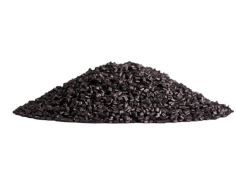Discover how graphene masterbatch for epoxy resin is transforming industries. By integrating this advanced material, manufacturers can unlock unprecedented performance enhancements in epoxy systems, leading to superior composites, coatings, and adhesives. Explore the innovative possibilities and significant graphene masterbatch epoxy benefits that are pushing the boundaries of material science.

Epoxy resins are renowned for their excellent adhesive properties, chemical resistance, and mechanical strength, making them indispensable in various applications from construction to aerospace. However, their inherent limitations in areas like electrical conductivity, thermal dissipation, and toughness in certain scenarios have driven the search for effective modifiers. This is where graphene masterbatch for epoxy resin emerges as a game-changer. A masterbatch is a concentrated form of a material, in this case, graphene, dispersed within a carrier resin. This format simplifies the process of incorporating graphene into epoxy formulations, ensuring uniform dispersion without the handling challenges associated with raw graphene powder.
Using an advanced graphene masterbatch ensures that the exceptional properties of graphene – its incredible strength, high electrical and thermal conductivity, and large surface area – are effectively transferred to the epoxy matrix. Unlike simple fillers, graphene interacts intimately with the polymer chains, creating a truly graphene-enhanced epoxy resin. This leads to a synergistic effect where the composite material exhibits properties far superior to those of the individual components. The key to unlocking these benefits lies in the quality of the masterbatch and the dispersion process, highlighting the importance of using a high-performance graphene masterbatch.
The unique graphene masterbatch properties are derived directly from the single-atom-thick structure of graphene itself. When incorporated correctly into epoxy, these properties manifest as significant improvements:
These enhancements demonstrate the transformative potential of using graphene in epoxy resin formulations across diverse sectors.
The integration of graphene masterbatch for epoxy resin is no longer purely theoretical; it is actively being implemented in a wide range of industrial applications. The versatility and enhanced performance offered by epoxy resin graphene applications are driving innovation in critical sectors.
In aerospace and automotive industries, weight reduction and enhanced structural integrity are paramount. Graphene composite materials based on epoxy are being developed for lightweight structural components, interior panels, and even conductive parts for de-icing systems or sensor integration. The high strength-to-weight ratio of graphene-enhanced epoxy resin makes it ideal for demanding environments where performance and efficiency are critical. Examples include composite wings, body panels, and battery housings that benefit from improved mechanical and thermal properties.
The benefits of graphene in coatings are numerous. Graphene-enhanced epoxy coatings offer superior scratch resistance, corrosion protection, and chemical resistance. Conductive epoxy coatings are used for ESD floors in electronics manufacturing or anti-static surfaces. Furthermore, the enhanced barrier properties are invaluable for protective coatings in harsh environments. In adhesives, graphene additives for resin applications can improve bond strength, durability, and thermal performance, crucial for structural bonding in automotive and construction.
The electronics industry heavily relies on materials that can manage heat effectively and provide necessary electrical properties. Epoxy applications of graphene include thermal interface materials, conductive adhesives for component bonding, and encapsulation materials that dissipate heat from sensitive electronics. Using graphene in epoxy resin allows for the creation of lightweight, yet highly functional components critical for modern electronic devices.
For construction, graphene-enhanced epoxy resin is used in high-strength adhesives for structural repairs, durable floor coatings, and corrosion-resistant rebar coatings. The improved mechanical properties and durability contribute to the longevity and safety of infrastructure projects. Industrial use of graphene in epoxy in this sector is growing as engineers recognize its potential to create more resilient building materials.
Marine environments are notoriously corrosive. Graphene-enhanced epoxy coatings provide exceptional protection against saltwater, abrasion, and fouling, extending the lifespan of boats, ships, and offshore structures. The enhanced barrier properties of the graphene masterbatch for epoxy resin are particularly beneficial here.
These examples illustrate the broad impact of innovative graphene solutions for epoxy across various sectors, showcasing how this material is driving significant performance improvements and enabling new functionalities.
Effective performance optimization with graphene in epoxy resins hinges on several factors, primarily the quality of the graphene masterbatch production process and the subsequent dispersion within the epoxy matrix. A well-produced masterbatch ensures that graphene is uniformly distributed and exfoliated, preventing agglomeration which can negate the benefits of the nanomaterial.
Choosing the right advanced graphene masterbatch is crucial. Different applications may require different types of graphene (e.g., graphene nanoplatelets, few-layer graphene) and different carrier resins within the masterbatch to ensure compatibility with the specific epoxy system. Companies offering custom graphene masterbatches can tailor the formulation to meet unique performance requirements, optimizing factors like conductivity, viscosity, and processing temperature.
Furthermore, considering the environmental impact, the development of environmentally friendly graphene masterbatch solutions is gaining traction. This involves using sustainable production methods and ensuring the masterbatch itself contributes to a more sustainable end product by improving durability and reducing the need for frequent replacements.
Integrating graphene additives for resin applications requires careful formulation and processing techniques. While masterbatches simplify handling, proper mixing procedures are still necessary to achieve optimal dispersion and unlock the full potential of the graphene composite materials. Collaboration with suppliers knowledgeable in graphene in polymer modifications is highly beneficial for successful implementation.
The continuous research and development in graphene masterbatch for epoxy resin are constantly expanding the possibilities. As production methods become more efficient and cost-effective, the adoption of graphene-enhanced epoxies is expected to accelerate, leading to a new generation of high-performance materials across numerous industries.
Ready to elevate your epoxy resin applications with cutting-edge graphene technology?
Learn More About Our Graphene MasterbatchesUnlock the full potential of your epoxy applications with our expert graphene solutions.
Contact Us for Graphene Solutions